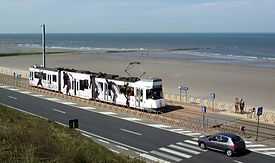Coast Tram (Belgium)

| Belgian Coast Tram | |||||||||||||||||||||||||||||||||||||||||||||||||||||||||||||||||||||||||||||||||||||||||||||||||||||||||||||||||||||||||||||||||||||||||||||||||||||||||||||||||||||||||||||||||||||||||||||||||||||||||||||||||||||||||||||||||||||||||||||||||||||||||||||||||||||||||||||||||||||||||||||||||||||||||||||||||||||||||||||||||||||||||||||||||||||||||||||||||||||||||||||||||||||||||||||||||||||||||||||||||||||||||||||||||||||||||||||||||||||||||||||||||||||||||||||||||||||||||||||||||||||||||||||||||||
|---|---|---|---|---|---|---|---|---|---|---|---|---|---|---|---|---|---|---|---|---|---|---|---|---|---|---|---|---|---|---|---|---|---|---|---|---|---|---|---|---|---|---|---|---|---|---|---|---|---|---|---|---|---|---|---|---|---|---|---|---|---|---|---|---|---|---|---|---|---|---|---|---|---|---|---|---|---|---|---|---|---|---|---|---|---|---|---|---|---|---|---|---|---|---|---|---|---|---|---|---|---|---|---|---|---|---|---|---|---|---|---|---|---|---|---|---|---|---|---|---|---|---|---|---|---|---|---|---|---|---|---|---|---|---|---|---|---|---|---|---|---|---|---|---|---|---|---|---|---|---|---|---|---|---|---|---|---|---|---|---|---|---|---|---|---|---|---|---|---|---|---|---|---|---|---|---|---|---|---|---|---|---|---|---|---|---|---|---|---|---|---|---|---|---|---|---|---|---|---|---|---|---|---|---|---|---|---|---|---|---|---|---|---|---|---|---|---|---|---|---|---|---|---|---|---|---|---|---|---|---|---|---|---|---|---|---|---|---|---|---|---|---|---|---|---|---|---|---|---|---|---|---|---|---|---|---|---|---|---|---|---|---|---|---|---|---|---|---|---|---|---|---|---|---|---|---|---|---|---|---|---|---|---|---|---|---|---|---|---|---|---|---|---|---|---|---|---|---|---|---|---|---|---|---|---|---|---|---|---|---|---|---|---|---|---|---|---|---|---|---|---|---|---|---|---|---|---|---|---|---|---|---|---|---|---|---|---|---|---|---|---|---|---|---|---|---|---|---|---|---|---|---|---|---|---|---|---|---|---|---|---|---|---|---|---|---|---|---|---|---|---|---|---|---|---|---|---|---|---|---|---|---|---|---|---|---|---|---|---|---|---|---|---|---|---|---|---|---|---|---|---|---|---|---|---|---|---|---|---|---|---|---|---|---|---|---|---|---|---|---|---|---|---|---|---|---|---|---|---|---|---|---|---|---|---|---|---|---|---|---|---|---|---|---|---|---|---|---|---|---|---|---|---|---|---|---|---|---|---|---|---|---|---|---|---|---|---|---|---|---|---|---|---|---|---|---|---|---|---|---|---|---|---|---|---|---|---|---|---|---|---|---|---|---|---|---|---|---|---|
Legend
| |||||||||||||||||||||||||||||||||||||||||||||||||||||||||||||||||||||||||||||||||||||||||||||||||||||||||||||||||||||||||||||||||||||||||||||||||||||||||||||||||||||||||||||||||||||||||||||||||||||||||||||||||||||||||||||||||||||||||||||||||||||||||||||||||||||||||||||||||||||||||||||||||||||||||||||||||||||||||||||||||||||||||||||||||||||||||||||||||||||||||||||||||||||||||||||||||||||||||||||||||||||||||||||||||||||||||||||||||||||||||||||||||||||||||||||||||||||||||||||||||||||||||||||||||||
The Coast Tram (Dutch: Kusttram) is a public transport service connecting the cities and towns along the entire Belgian (West Flanders) coast, between De Panne near the French border and Knokke-Heist. At 68 km (42 miles) in length, it is the longest tram line in the world,[1] as well as one of the few interurban tramways in the world to remain in operation. The line is built at 1,000 mm (3 ft 3 3⁄8 in) metre gauge and fully electrified at 600 V DC.
History
The first section of the track between Oostende and Nieuwpoort was brought into service in 1885, although the original route was further inland than the modern one and only short sections in Oostende and Nieuwpoort centres are still in operation. On its creation, the line was managed by the NMVB (National Neighbourhood Railway Company). In 1991, the NMVB/SNCV was broken into two regional companies, one Walloon and the other Flemish, with the Flemish successor company, Vlaamse Vervoermaatschappij De Lijn taking responsibility for operation of the coastal tram.
Characteristics

The service makes 69 stops along the 68 km long line, with a tram running every ten minutes during the peak summer months (every 20 mins in the winter months), during which it is used by over 3 million passengers. The service has recently been made more accessible through the addition of low-floor centre sections to existing vehicles, and the introduction of a few new HermeLijn low-floor trams.
While most of the older trams are unidirectional, and thus have to be turned on a loop in order to reverse direction, the newer ones are bi-directional, with driving positions and doors on both end/sides.
An interesting feature is the two alternative routes that exist around either end of the Leopoldkanaal locks just east of Zeebrugge, and the similar single track diversion around the inland end of the Boudewijnkanaal lock. This avoids delays to the tram schedule when the road bridge that the tram line normally follows is raised for boats passing under it. A similar feature exists at the southern end of Ostend station around the lock entrance to the Vlotdok.
Gallery
-
Tram in Oostende Henegouwenstraat stop
-
Ostend (tram and rail) station
-

Tram in Oostende station
-
Tram in depot of Ostend
-
Tram leaving De Haan station
-
De Haan station
-
A couple of trams in De Haan station
-

Tracks between De Haan and Wenduine
-
Depot at Adinkerke
-

Classic tram in 1980s
-

1986
-

Oostende in 1982
-

Also in 1982 Oostende
See also
References
- ↑ "Facts & Figures". Yarra Trams. Retrieved 16 April 2013.
External links
| Wikimedia Commons has media related to Coastal tram, Belgium. |
- (Dutch) De Kusttram (Official site)
- (Dutch) De Lijn (Official site)
- (Dutch) Buurtspoorweg foto archief
- (Dutch) TRAMANIA Buurtspoorweg sponsoring
- (English) UrbanRail.net page
| |||||||||||||||||||||||||
| ||||||






